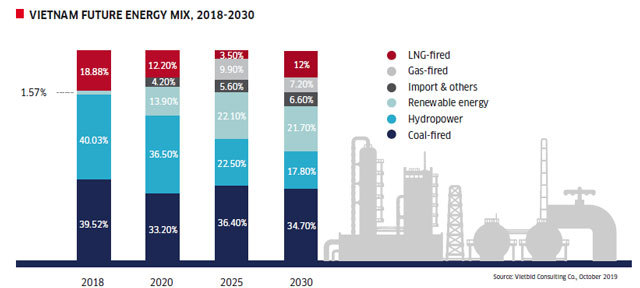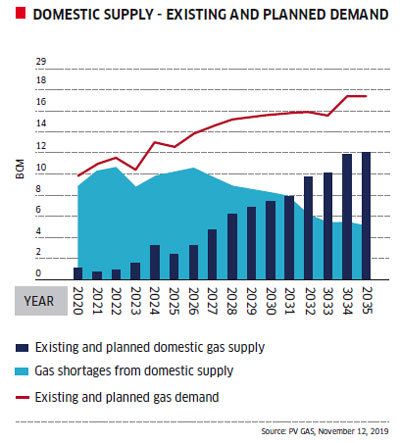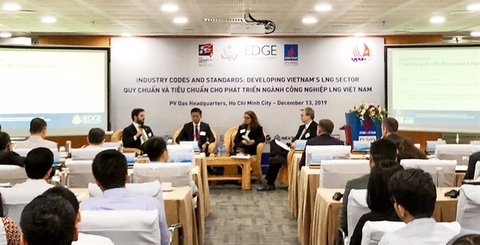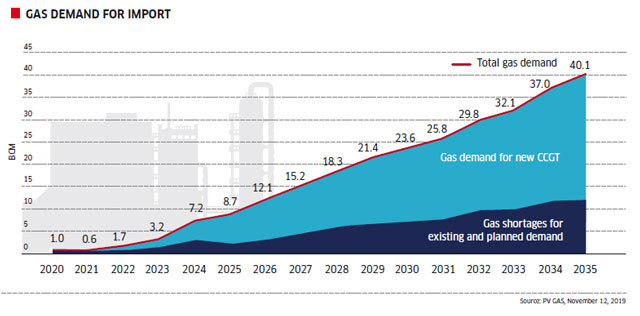 |
The US-based AES Corporation (AES) will soon begin construction of the Son My 2 combined cycle gas turbine (CCGT) power plant in south-central Binh Thuan province after signing an MoU in November with the Ministry of Industry and Trade.
The $1.7-billion LNG-fired plant will operate under a 20-year government contract. “LNG will be the key to Vietnam’s growing energy demand, by offering a cleaner, more reliable, and more affordable energy solution,” Mr. Mark Green, AES Eurasia President, told VET.
“This MoU is a significant milestone towards the development of the Son My 2 power plant, which we believe will help transform Vietnam’s energy sector.”
Projects underway and to come
In addition to Son My 2, AES’s investment plans in gas infrastructure in the country include the $1.4-billion Son My LNG import terminal, which received approval from the government in August, bring its total investment in gas infrastructure to $3.1 billion.
The US investor expects the plant and terminal will play a major role in shaping Vietnam’s energy future by diversifying the energy mix with imported LNG and will also meet the country’s rising demand for sustainable and affordable electricity.
The AES projects are one of two LNG project to come into being in Vietnam. The State-owned PetroVietnam Gas Corporation (PV GAS) and its partners were set to begin construction of the Thi Vai LNG terminal, one of the first in Vietnam’s south, in October. PV GAS is still in the process of reviewing the remaining design issues concerning the terminal with consultants and contractors before construction can begin.
The terminal is expected to be put into operation in the third quarter of 2022 and will have a capacity of 1 million metric tons per year by 2022 in its first phase, and 3 million metric tons per year by 2023 in its second phase.
Together with the Son My LNG terminal, with a capacity upon completion of 10 million metric tons of LNG per year, energy demand in the southern region is virtually guaranteed into the future, according to PV GAS General Director Duong Manh Son.
 |
||
|
|
Many foreign investors from the US, Thailand, Japan, and Norway, such as SET-listed firms B.Grimm Power Plc and Gulf Energy Development Plc, are looking at Vietnam for new LNG energy projects as a result of the Thai government failing to open up the country’s LNG market.
Vietnam, meanwhile, is struggling to develop its energy industry given that many coal-fired projects are behind schedule, its hydropower potential is almost exhausted, and oil and gas reserves are running low. The government is therefore seeking cooperation with local and international companies in the LNG industry, and much activity is being seen.
In early November, B.Grimm and the PetroVietnam Power Corporation signed a cooperation agreement on the development of integrated LNG projects. On the sidelines of the 35th ASEAN Summit and Related Summits held in Thailand, Gulf and the Ninh Thuan Provincial People’s Committee signed an agreement to study the feasibility of building an $8 billion LNG power plant in Ca Na in the south-central province, which will have a capacity of 6,000MW and be fully equipped with an LNG processing and distribution station to support economic and urban expansion in the southern region.
At the same time, Gen X Energy is studying opportunities to invest in LNG power projects in Vietnam, having met with the Ba Ria Vung Tau Provincial People’s Committee in September to discuss a proposal to invest some $6 billion in a complex of LNG projects, including storage facilities, a transportation network, and a power plant, in the southern province.
In September, the Hanoi-based Delta Offshore Energy (DeltaOE) and the Houston-based LNG Limited signed a deal with the Bac Lieu Provincial People’s Committee in the Mekong Delta to develop an LNG-to-power project that will use LNG from Louisiana.
The project includes an LNG import terminal and a 3,200MW CCGT power plant on a total area of 140 ha, including land and ocean surface. Expected to commence operations by 2023, the project will sell electricity to Bac Lieu under a power purchase agreement (PPA) that is yet to be finalized.
Mr. Ian Nguyen, Managing Director, Origination and Government Relations, at DeltaOE, feels good about the long-term prospects for the development of LNG in Vietnam. Delayed coal projects may be switched to gas / LNG, while native gas developments are facing delays and could be substituted with competitive LNG.
LNG is a competitive fuel for industry and also cleaner, and can supplement the limited supply of compressed natural gas (CNG). “Growth in renewable energy will need flexible generation to balance the grid,” he told VET. “CCGTs are perfect for flexible power generation.”
Future expectations
 |
According to the Ministry of Industry and Trade (MoIT), Vietnam will face severe power shortages from 2021 as demand outpaces the construction of new plants. Electricity demand is expected to exceed supply by 6.6 billion kWh in 2021 and 15 billion kWh in 2023. Vietnam will need an average of $6.7 billion in investment each year during the 2016-2030 period to expand its annual power generation capacity by 10 per cent.
In the revised Power Development Plan (PDP) 7, during the 2025-2030 period, Vietnam will need new LNG power plants with a total capacity of approximately 15,000 - 19,000MW to meet the rapid growth in power demand. Its gas supply, meanwhile, is forecast to fall short of demand from 2020, due to a decline in the country’s gas reserves and the delayed development of new gas fields, which make it necessary to import more LNG to supplement supplies for power plants in the south of the country.
In November, Minister of Industry and Trade Tran Tuan Anh told an LNG producer-consumer conference in Tokyo that developing LNG has become necessary in Vietnam to ensure energy security. Vietnam is set to import some 5 million tons of LNG by 2025, 10 million tons by 2030, and 15 million tons by 2035. “The country is developing a legal framework for LNG and giving priority to LNG projects,” he said.
The government will need to approve the legal framework in the proposed PDP8, which gives local and foreign investors in LNG projects a clear roadmap on what they can do, according to Mr. Nguyen Thanh Ha, CEO of Vietbid, a Vietnamese consulting company. Existing LNG projects, in which investors had a deal with local authorities, are still in the process of feasibility studies and need to complete development and be included in the PDP8 for 2021. Projects are mostly being implemented under the build-operate-transfer (BOT) model, such as the AES and PV GAS projects.
BOT LNG projects, however, are being discouraged by the government, Mr. Tran Viet Ngai, Chairman of the Vietnam Energy Association, told VET.
“The government’s policy is to create favorable conditions for investors with capacity in technical resources and material supplies and with reasonable prices,” he said. “This, though, has become an obstacle to the development of LNG projects in Vietnam.”
LNG investments require large amounts of capital, which comes primarily from banks. In theory, local and international banks will provide loans with a government guarantee to investors, according to Mr. Ha. “If investors try fund projects by themselves, they will face commercial risks when selling electricity to the only Vietnamese buyer - Electricity of Vietnam (EVN) - which may decide not to buy,” he said.
Stakeholder alignment, though, is the most challenging issue. Various decision-makers need to fully understand their respect roles and responsibilities, especially when considering risk allocation, Mr. Nguyen from DeltaOE said. Investors can manage commercial risk but must depend on the government to manage other risks. Risk sharing must be fair for all sides.
Mr. Erik Nikolai Stavseth, Commercial Manager at Golar Power Limited, told VET that the company needs a clear regulatory, legal, and commercial framework and a long-term commitment from the government and the local community. The Norwegian company is cooperating with local partners in investing and developing advanced solutions and technologies such as floating storage and regasification (FSRU) for a number of upcoming LNG projects.
“We take an integrated approach -meaning that we want to not only provide an FSRU or a power plant (or supply of LNG), but are interested in working with the client (whichever Vietnamese counterparty it may be) to ensure delivering a total package. We have a long track-record on FSRUs and the maritime environment, but at the same time gained substantial experience on power generation,” he added.
“MoIT, as the main responsible agency, and in coordination with other relevant agencies, should guide investors on implementing steps to prepare investment,” Mr. Stavseth added.
Mr Richard Tyrrell, Chief Development Officer at Hoegh LNG, told VET that energy policy is a complex matter for all countries and Vietnam is no exception. Timely decision making and regulatory stability are the most critical factors, he believes. LNG has a lot to offer given its price advantage over the liquid fuels that are today making up for falls in pipeline gas supply.
He expects Vietnam to add to the 42 countries and territories importing LNG in 2020, through one of its FSRUs, as a way to meet its ambitious timetable while ensuring cost effectiveness and flexibility in the longer-term. VN Economic Times
Nghi Do

US partners with PV Gas on raising Viet Nam’s LNG standards
The application of international LNG standards would ensure safety in the design, construction and implementation of infrastructure projects in Vietnam, a US official said.

US firms are pouring money into Vietnam LNG market
Investing in the Vietnamese LNG market shows a diversified investment portfolio and part of efforts to balance the two-way trade.
 Foreign investors need a smoother passage before bringing much-needed LNG projects to life in Vietnam.
Foreign investors need a smoother passage before bringing much-needed LNG projects to life in Vietnam.